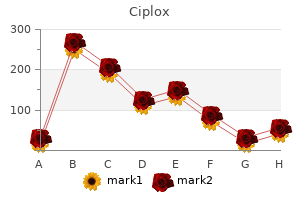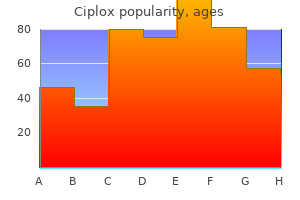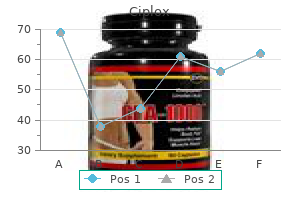"Discount ciplox online, antibiotics groups".
By: D. Ivan, M.A., Ph.D.
Co-Director, Pennsylvania State University College of Medicine
This feedback mechanism ensures an uninterrupted supply of biologically active free T3 in the blood antimicrobial vs antibacterial cheap ciplox 500mg line. What single abnormality in the pituitary-thyroid-thyroid hormone target cell axis would explain all of these findings? Only those physiologic actions of thyroid hormone that influence fuel metabolism are considered here antibiotic knee spacer surgery buy 500 mg ciplox with visa. It is important to stress the term physiologic antibiotics for acne while pregnant buy ciplox without prescription, because the effects of supraphysiologic concentrations of thyroid hormone on fuel metabolism may not be simple extensions of their physiologic effects infection 3 months after miscarriage buy 500 mg ciplox fast delivery. The increase in the secretion of thyroid hormone may or may not be adequate to fully compensate for the relative resistance of the peripheral tissues to thyroid hormone. If the compensatory increase in the secretion of thyroid hormone is inadequate, the patient may develop the signs and symptoms of hypothyroidism. Effects of Thyroid Hormone on the Liver Several of the actions of thyroid hormone affect carbohydrate and lipid metabolism in the liver. Thyroid hormone increases glycolysis and cholesterol synthesis and increases the conversion of cholesterol to bile salts. Through its action of increasing the sensitivity of the hepatocyte to the gluconeogenic and glycogenolytic actions of epinephrine, T3 indirectly increases hepatic glucose production (permissive or facilitatory action). Because of its ability to sensitize the adipocyte to the lipolytic action of epinephrine, T3 increases the flow of fatty acids to the liver and thereby indirectly increases hepatic triacylglycerol synthesis. The concurrent increase in the flow of glycerol to the liver (as a result of increased lipolysis) further enhances hepatic gluconeogenesis. Effects of Thyroid Hormone on the Adipocyte T3 has an amplifying or facilitatory effect on the lipolytic action of epinephrine on the fat cell. Yet thyroid hormone has a bipolar effect on lipid storage, because it increases the availability of glucose to the fat cell, which serves as a precursor for fatty acid and glycerol 3-phosphate synthesis. The major determinant of the rate of lipogenesis, however, is not T3, but rather the amount of glucose and insulin available to the adipocyte for triacylglycerol synthesis. Effects of Thyroid Hormone on Muscle In physiologic concentrations, T3 increases glucose uptake by muscle cells. It also stimulates protein synthesis, and, therefore, growth of muscle, through its stimulatory actions on gene expression. In physiologic concentrations, thyroid hormone sensitizes the muscle cell to the glycogenolytic actions of epinephrine. Effects of Thyroid Hormone on the Pancreas When present in excess, T3 has severe catabolic effects that increase the flow of amino acids from muscle into the blood and eventually to the liver. Thyroid hormone increases the sensitivity of the cells of the pancreas to those stimuli that normally promote insulin release and is required for optimal insulin secretion. This relative inefficiency of the human "engine" leads to the production of heat as a consequence of fuel utilization. This inefficiency, in part, allows homeothermic animals to maintain a constant body temperature in spite of rapidly changing environmental conditions. The acute response to cold exposure is shivering, which is probably secondary to increased activity of the sympathetic nervous system in response to this "stressful" stimulus. Thyroid hormone participates in this acute response by sensitizing the sympathetic nervous system to the stimulatory effect of cold exposure. The effects of T3 on the sympathetic nervous system increase the release of norepinephrine. Gastrointestinal-Derived Hormones Affecting Fuel Metabolism In addition to insulin and the counterregulatory hormones discussed, a variety of peptides synthesized in the endocrine cells of the pancreatic islets, or the cells of the enteric nervous system, or the endocrine cells of the stomach, small bowel and large bowel, as well as certain cells of the central and peripheral nervous system, influence fuel metabolism directly. Some of these peptides and their tissue of origin, their actions on fuel metabolism, and the factors that stimulate (or suppress) their secretion are listed in Table 43. For example, gastrin induces gastric acid secretion, which ultimately affects nutrient absorption and metabolism. Motilin, secreted by enteroendocrine M cells of the proximal small bowel, stimulates gastric and pancreatic enzyme secretion, which, in turn, influences nutrient digestion.


Similarly most common antibiotics for sinus infection order generic ciplox canada, elevation of the mandible is the upward movement of the lower jaw used to close the mouth or bite on something bacteria that causes tuberculosis order discount ciplox on line, and depression is the downward movement that produces opening of the mouth (see Figure 9 antibiotic resistance discussion questions buy ciplox mastercard. You can feel this rotation when you pick up a load virus 7 life processes buy ciplox 500 mg fast delivery, such as a heavy book bag and carry it on only one shoulder. To increase its weight-bearing support for the bag, the shoulder lifts as the scapula superiorly rotates. Inferior rotation occurs during limb adduction and involves the downward motion of the glenoid cavity with upward movement of the medial end of the scapular spine. The movements that are allowed are determined by the structural classification for each joint. For example, a multiaxial ball-and-socket joint has much more mobility than a uniaxial hinge joint. However, the ligaments and muscles that support a joint may place restrictions on the total range of motion available. The orientation of the articular processes at these joints varies in different regions of the vertebral column and serves to determine the types of motions available in each vertebral region. In the neck, the articular processes of cervical vertebrae are flattened and generally face upward or downward. This orientation provides the cervical vertebral column with extensive ranges of motion for flexion, extension, lateral flexion, and rotation. In the thoracic region, the downward projecting and overlapping spinous processes, along with the attached thoracic cage, greatly limit flexion, extension, and lateral flexion. The lumbar region allows for considerable extension, flexion, and lateral flexion, but the orientation of the articular processes largely prohibits rotation. This articulation has a pronounced U-shaped curvature, oriented along the anterior-posterior axis. The paired superior articular processes of the axis articulate with the inferior articular processes of the atlas. The third articulation is the pivot joint formed between the dens, which projects upward from the body of the axis, and the inner aspect of the anterior arch of the atlas (Figure 9. A strong ligament passes posterior to the dens to hold it in position against the anterior arch. With the mouth closed, the mandibular condyle and articular disc are located within the mandibular fossa of the temporal bone. During opening of the mouth, the mandible hinges downward and at the same time is pulled anteriorly, causing both the condyle and the articular disc to glide forward from the mandibular fossa onto the downward projecting articular tubercle. The net result is a forward and downward motion of the condyle and mandibular depression. This ligament spans the distance between the base of the skull and the lingula on the medial side of the mandibular ramus. Pharmacologic agents for pain or other therapies, including bite guards, are used as treatments. During depression of the mandible (opening of the mouth), the mandibular condyle moves both forward and hinges downward as it travels from the mandibular fossa onto the articular tubercle. It has a loose articular capsule and is supported by ligaments and the rotator cuff muscles. The large range of motions at the shoulder joint is provided by the articulation of the large, rounded humeral head with the small and shallow glenoid cavity, which is only about one third of the size of the humeral head. The socket formed by the glenoid cavity is deepened slightly by a small lip of fibrocartilage called the glenoid labrum, which extends around the outer margin of the cavity. The articular capsule that surrounds the glenohumeral joint is relatively thin and loose to allow for large motions of the upper limb. Some structural support for the joint is provided by thickenings of the articular capsule wall that form weak intrinsic ligaments. These include the coracohumeral ligament, running from the coracoid process of the scapula to the anterior humerus, and three ligaments, each called a glenohumeral ligament, located on the anterior side of the articular capsule. However, the primary support for the shoulder joint is provided by muscles crossing the joint, particularly the four rotator cuff muscles. In addition to their individual actions of moving the upper limb, the rotator cuff muscles also serve to hold the head of the humerus in position within the glenoid cavity.

Glucose is the major fuel for tissues such as the brain and neural tissue bacteria cell buy ciplox 500 mg mastercard, and the sole fuel for red blood cells virus 63 buy discount ciplox 500mg. Most neurons lack enzymes required for oxidation of fatty acids antibiotic cephalexin discount ciplox 500 mg with mastercard, but can use ketone bodies to a limited extent should i use antibiotics for sinus infection purchase ciplox discount. Red blood cells lack mitochondria, which contain the enzymes of fatty acid and ketone body oxidation, and can use only glucose as a fuel. Therefore, it is imperative that blood glucose not decrease too rapidly nor fall too low. Initially, liver glycogen stores are degraded to supply glucose to the blood, but these stores are limited. Although liver glycogen levels may increase to 200 to 300 g after a meal, only approximately 80 g remain after an overnight fast. Fortunately, the liver has another mechanism for producing blood glucose, known as gluconeogenesis. In gluconeogenesis, lactate, glycerol, and amino acids are used as carbon sources to synthesize glucose. As fasting continues, gluconeogenesis progressively adds to the glucose produced by glycogenolysis in the liver. His fasting blood glucose determined on the morning of his second day of hospitalization was 72 mg/dL (normal, overnight fasting 80100 mg/dL). Thus, in spite of his malnutrition and his overnight fast, his blood glucose was being maintained at nearly normal levels through gluconeogenesis using amino acid precursors. If his blood glucose had decreased below 50 to 60 mg/dL during fasting, his brain would have been unable to absorb glucose fast enough to obtain the glucose needed for energy and neurotransmitter synthesis, resulting in coma and eventual death. Although many other tissues, such as the red blood cell, are also totally or partially dependent on glucose for energy, they are able to function at lower concentrations of blood glucose than the brain. The circled numbers serve as a guide indicating the approximate order in which the processes begin to occur. After 12 hours of fasting, most of his tissues are using fatty acids as a major fuel, and the liver is beginning to produce ketone bodies from fatty acids. Lactate is a product of glycolysis in red blood cells and exercising muscle, glycerol is obtained from lipolysis of adipose triacylglycerols, and amino acids are generated by the breakdown of protein. Because our muscle mass is so large, most of the amino acid is supplied from degradation of muscle protein. These compounds travel in the blood to the liver, where they are converted to glucose by gluconeogenesis. Because the nitrogen of the amino acids can form ammonia, which is toxic to the body, the liver converts this nitrogen to urea. It is a very soluble, nontoxic compound that can be readily excreted by the kidneys and thus is an efficient means for disposing of excess ammonia. As fasting progresses, gluconeogenesis becomes increasingly more important as a source of blood glucose. After a day or so of fasting, liver glycogen stores are depleted and gluconeogenesis is the only source of blood glucose. Role of Adipose Tissue During Fasting Adipose triacylglycerols are the major source of energy during fasting. They supply fatty acids, which are quantitatively the major fuel for the human body. Fatty acids are not only oxidized directly by various tissues of the body; they are also partially oxidized in the liver to 4-carbon products called ketone bodies. As blood insulin levels decrease and blood glucagon levels rise, adipose triacylglycerols are mobilized by a process known as lipolysis. Thus, of the vast store of food energy in adipose tissue triacylglycerols, only the small glycerol portion travels to the liver to enter the gluconeogenic pathway. The acetyl CoA is converted to the ketone bodies acetoacetate and -hydroxybutyrate, which are released into the blood. However, ketone bodies can be further oxidized by most other cells with mitochondria, such as muscle and kidney.

Syndromes
- Has changes in size, shape, or color
- Have you been sick or injured recently?
- Taking "loop diuretics" to reduce potassium and fluid levels if you have chronic kidney failure
- Citric acid
- Swallowing difficulty
- Inflammation of tissues that line the wall of the abdomen and cover the abdominal organs
- The name of the product (ingredients and strengths if known)
- Secondary bacterial infections
- Chest x-ray
- Tuberculosis
Finally antibiotic resistance pbs safe ciplox 500 mg, stretching of the myometrium and cervix by a full-term fetus in the vertex (head-down) position is regarded as a stimulant to uterine contractions antibiotics for uti in late pregnancy purchase ciplox 500 mg with amex. The sum of these changes initiates the regular contractions known as true labor antibiotics for sinus infection diarrhea buy cheap ciplox 500 mg online, which become more powerful and more frequent with time antibiotics for pimples acne discount 500mg ciplox fast delivery. The pain of labor is attributed to myometrial hypoxia during uterine contractions. Stages of Childbirth the process of childbirth can be divided into three stages: cervical dilation, expulsion of the newborn, and afterbirth (Figure 28. However, it varies widely and may take minutes, hours, or days, depending in part on whether the mother has given birth before; in each subsequent labor, this stage tends to be shorter. Cervical stretching induces reflexive uterine contractions that dilate and efface the cervix further. In addition, cervical dilation boosts oxytocin secretion from the pituitary, which in turn triggers more powerful uterine contractions. When labor begins, uterine contractions may occur only every 330 minutes and last only 2040 seconds; however, by the end of this stage, contractions may occur as frequently as every 1. For this reason, it is critical that a period of relaxation occur after each contraction. Fetal distress, measured as a sustained decrease or increase in the fetal heart rate, can result from severe contractions that are too powerful or lengthy for oxygenated blood to be restored to the fetus. Such a situation can be cause for an emergency birth with vacuum, forceps, or surgically by Caesarian section. The amniotic membranes rupture before the onset of labor in about 12 percent of women; they typically rupture at the end of the dilation stage in response to excessive pressure from the fetal head entering the birth canal. It typically takes up to 2 hours, but it can last longer or be completed in minutes, depending in part on the orientation of the fetus. The vertex presentation known as the occiput anterior vertex is the most common presentation and is associated with the greatest ease of vaginal birth. The fetus faces the maternal spinal cord and the smallest part of the head (the posterior aspect called the occiput) exits the birth canal first. In fewer than 5 percent of births, the infant is oriented in the breech presentation, or buttocks down. Before the 1960s, it was common for breech presentations to be delivered vaginally. Vaginal birth is associated with significant stretching of the vaginal canal, the cervix, and the perineum. Until recent decades, it was routine procedure for an obstetrician to numb the perineum and perform an episiotomy, an incision in the posterior vaginal wall and perineum. Both an episiotomy and a perineal tear need to be sutured shortly after birth to ensure optimal healing. Although suturing the jagged edges of a perineal tear may be more difficult than suturing an episiotomy, tears heal more quickly, are less painful, and are associated with less damage to the muscles around the vagina and rectum. Afterbirth the delivery of the placenta and associated membranes, commonly referred to as the afterbirth, marks the final stage of childbirth. Continued uterine contractions then reduce blood loss from the site of the placenta. If the placenta does not birth spontaneously within approximately 30 minutes, it is considered retained, and the obstetrician may attempt manual removal. It is important that the obstetrician examines the expelled placenta and fetal membranes to ensure that they are intact. If fragments of the placenta remain in the uterus, they can cause postpartum hemorrhage. Although postpartum uterine contractions limit blood loss from the detachment of the placenta, the mother does experience a postpartum vaginal discharge called lochia. This is made up of uterine lining cells, erythrocytes, leukocytes, and other debris. Thick, dark, lochia rubra (red lochia) typically continues for 23 days, and is replaced by lochia serosa, a thinner, pinkish form that continues until about the tenth postpartum day.
Purchase 500 mg ciplox amex. Antimicrobial Resistance Solutions Initiative | Gonorrhoea antibiotic resistance.


